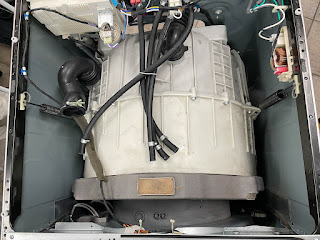I purchased a 20 year old Glendale Titanium 5th wheel last year - which hadn't received regular maintenance from what I could tell from various issues I've had with the unit. One issue was noisy operation of the landing gear, and vibration in the landing gear mechanism. Visual inspection of the landing gear mechanism in operation from the basement door showed the gearbox rotating back and forth about an inch on each revolution of the driveshaft, this clearly wasn't normal, plus I had broken tabs on the plastic gearbox case which allowed the gearbox to move excessively. I decided to make some repairs and try to resolve the noise and make the landing gear more reliable.
The first step was supporting the front of the fifth wheel. My truck has an 8' box and I've only got about 12" of clearance between the back of the box and the front of the basement when the truck is hooked up. I decided to crib up the front of the unit so I could take my time with the repair, and have good access to the basement to completely remove the landing gear.
 |
| Supporting the front with 4x4" cribbing |
Once I got the front of the unit supported on the cribbing - with the cribbing directly supporting the frame, I tested the stability before removing the landing gear. It wasn't quite as solid as I expected, so I installed some cross bracing and that removed any side to side movement on the cribbing. Two 2x4" did the trick nicely.
 |
| Cross bracing makes the cribbing much more stable. |
With the front now supported by the cribbing - removal of the landing gear is quite simple. Remove the leg extensions by undoing the pins and pulling them off the landing gear lower section, and then raise the lower sections completely to facilitate disassembly of the landing gear from the trailer frame.
 |
| Landing gear legs removed through the basement hatch. |
The landing gear is held to the frame by two c shaped brackets with bolt clamps. Simple to remove once the crossbar has been disassembled.
With the landing gear removed, disassembly is very straightforward. Belco, my local RV parts supply, had an aftermarket aluminum frame replacement gearbox at a reasonable price, about $100.
 |
| Aftermarket aluminum frame gearbox, dimensionally accurate. |
Swapping the gearbox is very simple - several long machine screws hold the motor to the gearbox. It's a straight swap.
 |
| Broken tab on plastic bodied OEM gearbox |
This is where I found the main shaft between the gearbox and the driven leg bevel gear was bent.
 |
| Thrust bearing, non-driven bevel gear shaft, and driven leg bevel gear shaft (bent) |
The gearbox came with a new bevel gear shaft, so that would take care of the rotation of the motor and gearbox on the driven landing gear leg. Close inspection of the short bevel gear shaft showed some damage to the shaft - a vertical crack in the shaft caused by the leg being driven to full stop under power. It would be a matter of time before this shaft fails.
 |
| Note the crack in the shaft running from the lower pin hole |
When I compared the two shafts, I noticed my longer bent shaft didn't have any cracks, and could be shortened to replace my shorter cracked shaft.
 |
| Hole drilled out in bent shaft, and marked to cut to length of the shorter shaft. |
 |
| Drilling out the shaft with a drill press. |
I also purchased a new set of bevel gears, which comes with new roll pins.
 |
| Disassembling, greasing, and replacing the acme screw. This is a messy job. |
 |
| Bevel gear disassembly - short shaft, roll pins, bevel gears, thrust bearing, thrust washer |
 |
| Acme screw regreasing. |
I don't have a lot of photos from this part of the operations - my hands were covered in high pressure grease - difficult to operate the camera with greasy hands and I wanted to get this part of the job done fairly quickly. Re-assembly was straightforward, as was replacement in the RV.
Once the landing gear was replaced in the RV, I resealed the openings around the landing gear legs with black silicone caulking. Black duct tape was used as a mould for the silicone, to help it set in place and keep the sealant tidy.
 |
| Black silicone sealant around the landing legs when reinstalled. |
Let me know if you have any questions - the whole job took a Saturday with all the parts in hand.
































